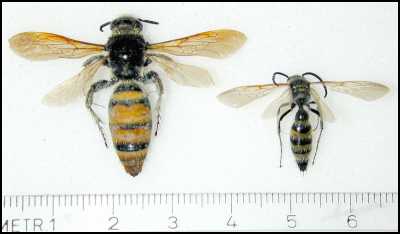New Wasp Species In Northland This Summer
DOC And MAF Ask Public To Be On The Lookout For New Wasp Species In Northland This Summer

The Department of Conservation (DOC) and Ministry of Agriculture and Fisheries (MAF) are on the hunt for an alien invader and is enlisting public help for the job.
Their target is an exotic species
of wasp called the Yellow Flower Wasp (Radumeris
tasmaniensis), which was discovered at three coastal sites
in Northland earlier this year. All three sites are
isolated sand dune areas, Twilight Beach and North Herekino
Head on the West Coast and Whareana Bay south of North
Cape.
DoC and MAF are now keen for anyone who may have
seen or who comes across this (20-40mm in length) insect
during the summer to notify DOC, MAF, or the Regional
Council as soon as possible so that work can start on
determining just how far the wasp has spread.
DOC Northland invertebrate expert Andrea Booth said the Yellow Flower Wasp is native to Australia and Papua New Guinea, and lives off the larvae of native beetles..
Instead of forming nests, the females tunnel into the soil and locate scarab beetle larvae which they sting and paralyse so that they can be used later by their hatched young as a food source as they grow.
Ms Booth said little is known about these wasps but that staff are keen to learn more about their behaviour and distribution within Northland.
“We will be working closely with MAF and the Northland Regional Council this summer to try and identify any other sites where these insects may be present and would like to hear from anyone who comes across them.,” Ms Booth said.
The public are also being asked to collect a specimen if practical and these can be dropped in or posted to your nearest Department of Conservation Office.
“The wasps can be collected by inverting a small jar or container over them and replacing the lid. The wasps can then be killed humanely by putting the container in the freezer for a few hours. To mail or transport we suggest you put the specimen in a film canister or another small container with a sealable lid,” Ms Booth said.
She asked that people send the samples to her at PO Box 842 Whangarei, and enclose a note stating when and where the wasps were found, and a contact name and phone number in case further details are required..
The female wasps are up to 30mm long with a wingspan of up to 40mm. The males are smaller, and about the size of a paper wasp. The females have a large, robust body, and the broad abdomen is orange with narrow black stripes across its width..
Males have a narrower abdomen with alternating black and yellow stripes of similar width. The wasps may be seen flying around close to the ground, especially on warm days in sheltered sites. So far, they have only been found in sand dunes, but they could potentially be found in other areas as well.
For more information please contact Andrea Booth (09) 430 2470


 PSA: PPPs Pose Risks To New Zealand Workers
PSA: PPPs Pose Risks To New Zealand Workers Office of the Privacy Commissioner: New Research Shows Business Leaders Fear Being On The Hook For Others’ Privacy Breaches
Office of the Privacy Commissioner: New Research Shows Business Leaders Fear Being On The Hook For Others’ Privacy Breaches E Tū: E Tū Members Send Open Letter To James Grenon And NZME Board
E Tū: E Tū Members Send Open Letter To James Grenon And NZME Board Commerce Commission: Commission Calls For Comments On Copper Access Deregulation
Commerce Commission: Commission Calls For Comments On Copper Access Deregulation New Zealand Association of Scientists: NZAS Supports Saving Biotechnology Capacity In Callaghan; Asks What Now For Applied Technology Group
New Zealand Association of Scientists: NZAS Supports Saving Biotechnology Capacity In Callaghan; Asks What Now For Applied Technology Group Stats NZ: Business Employment Data - December 2024 Quarter
Stats NZ: Business Employment Data - December 2024 Quarter



